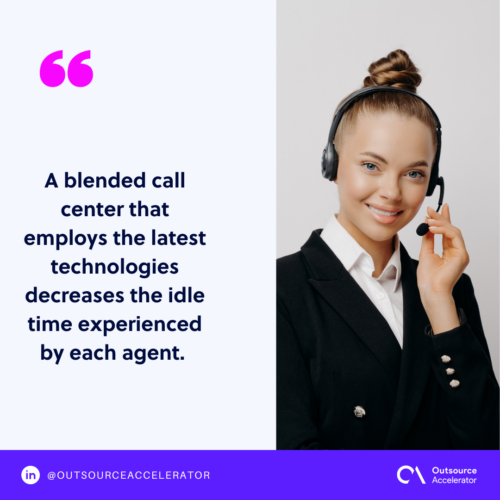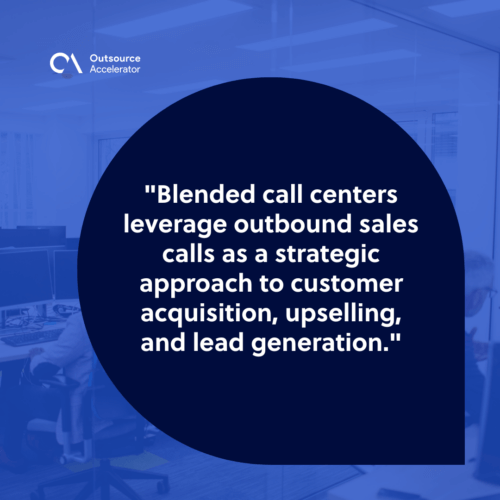Blended Call Center
Definition
What is a blended call center?
A blended call center handles both incoming and outgoing phone calls from customers. In blended call centers, both inbound and outbound call operations are treated.
The combination of automated call distribution and a predictive dialer in the telephony system is the secret to its success.
A blended call center that employs the latest technologies decreases the idle time experienced by each agent. Combining a call center with a delivery system will increase agent efficiency.

Advantages of a blended call center environment
The blended call center has several benefits, all of which can increase customer loyalty.
This type of call center can schedule outbound calls to check in with customers while inbound contact centers wait for the customer to ask for help.
Here are its other common advantages :
Higher rates of efficiency
When there are many calls or a call overflow, blended call center agents can collaborate to find the right solutions for their client’s businesses.
When running a marketing campaign for a particular period, blended professionals may even run an outbound campaign for companies.
Increase customer satisfaction
Blended call centers are a powerful component when it comes to improving user experiences and satisfaction.
Customer satisfaction can often arise due to better communication behind the scenes, enabled by cloud-based call center technology. Hence, consumers get the answers they need precisely when they need them.
Highly skilled team
Agents in blended call centers are very good at delivering valuable information about clients and can help plan marketing strategies accordingly.
Lower turnover rate
This type of call center’s constructive work schedule provides an enjoyable work atmosphere for its agents. The happier the workers are, the lower their turnover rate will be.
As a result, they will tend to be more trustworthy to work with.
Blended call center services
Blended call center offers services that seamlessly integrate both inbound and outbound interactions, such as:
Inbound customer support
Inbound customer support within a blended call center involves addressing customer queries. It offers technical assistance, troubleshooting issues, and providing comprehensive information about products or services.
Blended agents excel in delivering timely and effective solutions to enhance customer satisfaction.
Outbound sales call
Blended call centers leverage outbound sales calls as a strategic approach to customer acquisition, upselling, and lead generation.
Blended agents engage proactively with potential customers, showcasing products or services and converting leads into valuable clientele.
Follow-up services
Follow-up services play a crucial role in maintaining customer satisfaction.
Blended call centers conduct outbound calls to gather feedback, address customer concerns, and provide updates. This service ensures a continuous and positive customer relationship.
Appointment setting
Blended call centers excel in appointment setting through outbound calls. This service involves scheduling appointments, coordinating service visits, or arranging consultations.
It showcases the adaptability of the blended model to diverse business requirements.

Implementing blended contact center
Implementing the blended call centers encompasses several key steps and considerations to ensure their successful integration within an organization:
Assessment and planning
Begin by evaluating the current call center environment and identifying the specific needs and goals that blended contact centers can address.
Determine the volume of inbound and outbound calls, staffing requirements, and technological needs.
Technology integration
Invest in a robust contact center software system that supports both inbound and outbound functionalities.
This may include CRM systems, call routing software, predictive dialers, and analytics tools to optimize performance and data analysis.
Agent training and skill development
Provide comprehensive training programs for agents to equip them with the skills needed to handle both inbound and outbound calls effectively.
Training should focus on communication techniques, product knowledge, customer service, and sales strategies.
Operational workflow design
Develop a workflow that integrates both types of calls. Establish protocols for call handling, and prioritize tasks based on demand.
Create strategies for agents to transition between inbound and outbound calls smoothly.
Performance measurement and analytics
Implement systems to track and measure key performance metrics such as call resolution time, customer satisfaction, conversion rates, and overall productivity.
Analyze data regularly to identify areas for improvement.
Flexibility and adaptability
Ensure the system and workforce are flexible enough to adapt to fluctuating call traffic and changing customer needs. This adaptability is crucial for optimizing resources and maintaining service quality.
Continuous improvement
Regularly review and refine processes based on performance analytics and customer feedback. Encourage a culture of continuous improvement to enhance efficiency and customer satisfaction.
Change management and communication
Communicate the transition to a blended model transparently with the staff.
Provide support during the changeover and address any concerns to ensure a smooth implementation.







 Independent
Independent




